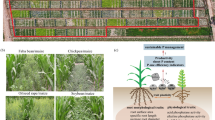Abstract
Greater productivity under intercropping has been attributed to the complementary use of environmental resources. However, the rooting pattern of component species under intercropping, which is an important morphological feature considering the complementary uptake of nutrients, has been studied only rarely under field conditions because of inherent technical difficulties. We examined rooting patterns of three green manure species, both sole cropped and intercropped, using a newly developed multi-color staining technique. Species were chosen from different functional groups: sorghum (Sorghum bicolor (L.) Moench.), a C4 grass; crotalaria (Crotalaria juncea L.), a legume; and sunflower (Helianthus annuus L.), a C3 dicot. We also investigated these species’ aboveground biomass and N uptake. Sorghum distributed roots deeper under intercropping than under sole cropping; it was the most important contributor to increased biomass under intercropping. Crotalaria had a deep rooting system under both sole cropping and intercropping. Sunflower, with a shallow rooting system, was suppressed extremely under intercropping, possibly because of water deficiency in late in the season. The rooting patterns of green manure species examined using multi-color staining were related closely to the aboveground performance of these species under intercropping.






Similar content being viewed by others
References
Andersen MK, Hauggaard-Nielsen H, Ambus P, Jensen ES (2004) Biomass production, symbiotic nitrogen fixation and inorganic N use in dual and tri-component annual intercrops. Plant Soil 266:273–287
Andersen MK, Hauggaard-Nielsen H, Weiner J, Jensen ES (2007) Competitive dynamics in two- and three-component intercrops. J Appl Ecol 44:545–551
Bellostas N, Hauggaard-Nielsen H, Andersen MK, Jensen ES (2003) Early interference dynamics in intercrops of pea, barley and oilseed rape. Biol Agric Hortic 21:337–348
Bulson HAJ, Snaydon RW, Stopes CE (1997) Effects of plant density on intercropped wheat and field beans in an organic farming system. J Agr Sci 128:59–71
Corre-Hellou G, Crozat Y (2005) Assessment of root system dynamics of species grown in mixtures under field conditions using herbicide injection and 15 N natural abundance methods: a case study with pea, barley and mustard. Plant Soil 276:177–192
Corre-Hellou G, Fustec J, Crozat Y (2006) Interspecific competition for soil N and its interaction with N-2 fixation, leaf expansion and crop growth in pea-barley intercrops. Plant Soil 282:195–208
Fan F, Zhang F, Song Y, Sun J, BaoX GT, Li L (2006) Nitrogen fixation of faba bean (Vicia faba L.) interacting with a non-legume in two contrasting intercropping systems. Plant Soil 283:275–286
Hauggaard-Nielsen H, Jensen ES (2001) Evaluating pea and barley cultivars for complementarity in intercropping at different levels of soil N availability. Field Crops Res 72:185–195
Hauggaard-Nielsen H, Jensen ES (2005) Facilitative root interactions in intercrops. Plant Soil 274:237–250
Hauggaard-Nielsen H, Ambus P, Jensen ES (2001) Temporal and spatial distribution of roots and competition for nitrogen in pea-barley intercrops—a field study employing 32P technique. Plant Soil 236:63–74
Hauggaard-Nielsen H, Andersen MK, Jørnsgaard B, Jensen ES (2006) Density and relative frequency effects on competitive interactions and resource use in pea–barley intercrops. Field Crops Res 95:256–267
Hawkes CV, Casper BB (2002) Lateral root function and root overlap among mycorrhizal and nonmycorrhizal herbs in a Florida shrubland, measured using rubidium as a nutrient analog. Am J Bot 89:1289–1294
Jensen ES (1996) Grain yield, symbiotic N2 fixation and interspecific competition for inorganic N in pea-barley intercrops. Plant Soil 182:25–38
Jolliffe PA (2000) The replacement series. J Ecol 88:371–385
Kahmen A, Perner J, Audorff V, Weisser W, Buchmann N (2005) Effects of plant diversity, community composition and environmental parameters on productivity in montane European grasslands. Oecologia 142:606–615
Kahmen A, Renker C, Unsicker SB, Buchmann N (2006) Niche complementarity for nitrogen: an explanation for the biodiversity and ecosystem functioning relationship? Ecology 87:1244–1255
Lambers JHR, Harpole WS, Tilman D, Knops J, Reich PB (2004) Mechanisms responsible for the positive diversity-productivity relationship in Minnesota grasslands. Ecol Lett 7:661–668
Loomis RS, Connor DJ (1992) Crop Ecology: productivity and management in agricultural systems. Cambridge University Press, Cambridge
Loreau M (2000) Biodiversity and ecosystem functioning: recent theoretical advances. Oikos 91:3–17
Murakami T, Shimano S, Kaneda S, Nakajima M, Urashima Y, Miyoshi N (2006) Multicolor staining of root systems in pot culture. Soil Sci Plant Nutr 52:618–622
Neumann A, Schmidtke K, Rauber R (2007) Effects of crop density and tillage system on grain yield and N uptake from soil and atmosphere of sole and intercropped pea and oat. Field Crop Res 100:285–293
Tilman D, Wedin D, Knops J (1996) Productivity and sustainability influenced by biodiversity in grassland ecosystems. Nature 379:718–720
Veresoglou DS, Fitter AH (1984) Spatial and temporal patterns of growth and nutrient uptake of five co-existing grasses. J Ecol 72:259–272
Ward KJ, Klepper B, Rickman RW, Allmaras RR (1978) Quantitative estimation of living wheat-root lengths in soil cores. Agron J 70:675–677
Wilson JB (1988) Shoot competition and root competition. J Appl Ecol 25:279–295
Wilson JB, Newman EI (1987) Competition between upland grasses: root and shoot competition between Deschampsia flexuosa and Festuca ovina. Acta Oecol-Oec Gen 8:501–509
Zhang F, Li L (2003) Using competitive and facilitative interactions in intercropping systems enhances crop productivity and nutrient-use efficiency. Plant Soil 248:305–312
Acknowledgements
We thank our excellent assistants—Mr. Takayoshi Mashiko, Mr. Kazuto Mine, and Ms. Takako Otomo—for their technical support. The Ministry of Education, Culture, Sports, Science and Technology (MEXT) Grant-in Aid for Scientific Research (KAKENHI) 19780015 supported this work.
Author information
Authors and Affiliations
Corresponding author
Additional information
Responsible Editor: Martin Weih.
An erratum to this article can be found at http://dx.doi.org/10.1007/s11104-010-0498-8
Rights and permissions
About this article
Cite this article
Miyazawa, K., Murakami, T., Takeda, M. et al. Intercropping green manure crops—effects on rooting patterns. Plant Soil 331, 231–239 (2010). https://doi.org/10.1007/s11104-009-0248-y
Received:
Accepted:
Published:
Issue Date:
DOI: https://doi.org/10.1007/s11104-009-0248-y




